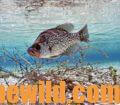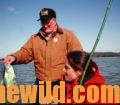Editor’s Note: This fall there’s been almost never-before very-high temperatures in the 90+ range. Where I live near Birmingham, Alabama, we’ve had 6 weeks of 95+ temperatures from late August through the first part of October. So, crappie fishermen must use summertime tactics to catch October crappie across much of the South. In other sections of the country, anglers will catch crappie with fall strategies. With 4 feet of snow falling in the U.S. Northwest the first week of October, some anglers must use winter methods to catch crappie there. This week, we’ll look at catching crappie now. Today’s crappie anglers are catching more and bigger crappie than ever before by going deep for crappie, which takes planning, close observation and special lure techniques for warm-weather crappie.
Try Weird Fall Crappie Methods:
Some of the best crappie hot spots I’ve ever found may seem weird to many crappie fishermen. Fishing underwater bridges and railroad trestles will pay off during the autumn months. Crappie hold on top of, along the side of or under sunken bridges, depending on the water clarity and temperature. I either vertical jig these sunken bridges or cast to them and let my jig fall down beside them. Ninety percent of the time, the crappie will take the jig on the fall. To catch these fish, you have to watch your line.
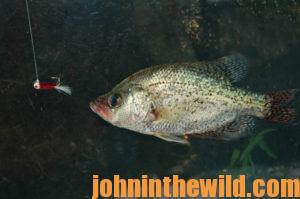 One of the strangest tactics I’ve ever used for fall crappie I learned from a longtime crappie pro, who told me that, “Once I was fishing with a jig and a slip bobber. I let my jig fall to about 4-1/2 feet. Because I knew crappie were holding in that depth, I fished in some submerged treetops I felt should home crappie. But I couldn’t make the fish bite. I cast my jig out once more. While the line slipped through the bobber this time, I became distracted watching a squirrel play in the treetops above where I was fishing. By the time I realized I should be watching my bobber, the bobber had vanished. I caught a very-nice crappie.
One of the strangest tactics I’ve ever used for fall crappie I learned from a longtime crappie pro, who told me that, “Once I was fishing with a jig and a slip bobber. I let my jig fall to about 4-1/2 feet. Because I knew crappie were holding in that depth, I fished in some submerged treetops I felt should home crappie. But I couldn’t make the fish bite. I cast my jig out once more. While the line slipped through the bobber this time, I became distracted watching a squirrel play in the treetops above where I was fishing. By the time I realized I should be watching my bobber, the bobber had vanished. I caught a very-nice crappie.
“So, I put a jig with a lead head, a rubber body and a marabou tail on a bobber in an aquarium. As I watched the jig, I noticed any small movement in the water caused that marabou tail to move like a string in the wind. I looked at the fish in the aquarium and saw they held their positions in the water by simply moving their tails slightly but not actually swimming. I realized when my cork was sitting still, the marabou tail on the jig moved just like a fish’s tail in the aquarium, even though the jig remained stationary. I believe when crappie are somewhat dormant in the fall and not wanting to bite and see a jig sitting still in the water with just its tail moving, they believe the jig presents an easy meal.”
Catch Fall and Early Winter Crappie Around Main River Channels with Darrell Baker:
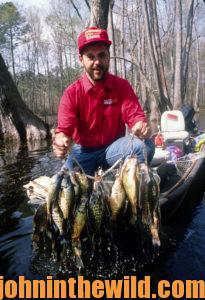 1) Realize That Dock Shooting Isn’t Just a Spring and Summer Crappie Catching Tactic – Most crappie fishermen who shoot docks for crappie view this tactic as a spring and summer way to take crappie. However, Darrell Baker of Centre, Alabama (256-557-0129)
1) Realize That Dock Shooting Isn’t Just a Spring and Summer Crappie Catching Tactic – Most crappie fishermen who shoot docks for crappie view this tactic as a spring and summer way to take crappie. However, Darrell Baker of Centre, Alabama (256-557-0129)
(http://weisslakecrappieguides.com and http://www.weisslakeguides.com) has learned that fall and winter months also are productive times of the year to shoot docks for crappie. During the fall and winter, fewer anglers are out fishing, and the crappie often will school-up under docks then. During the fall and winter months, you’ll rarely if ever see a crappie fisherman shooting docks.
“October is one of my most-productive months for catching large numbers of big crappie under docks,” Baker explains. “I still can catch crappie under docks during November and often into the winter months. In Alabama where I live, the water temperature during the first of October may be in the 80-90 degree ranges. But when the water temperature begins to fall, the crappie know that winter is on the way, and they need to feed aggressively to put on weight for the winter. So, they will move up from the deeper water and get in the cooler water under the docks and begin to feed heavily. Because docks have shade and algae growing on the brush and the pilings under a dock, the bait fish will move into this area and start feeding. Then the crappie will feed on the bait fish.
“Most of the docks I shoot, I’ll catch crappie in the places that are hardest for an angler to get a lure to, and in the darkest part of the dock, which generally will be the center of the dock. So, I like to shoot as far back under the dock as I can, even if that means my jig is only going to land in 6 inches of water. But by shooting that far under the dock, as I slowly reel my jig toward the front of the dock, as soon as I get a bite, I know where on the dock the crappie are and at what water depth they’re holding. The most crappie I’ve ever caught off one dock was 56 keeper crappie.”
2) Use Spider Rigging and Small Hooks in Thick Brush for Crappie
- a) Spider Rigging – When I hear the words, spider rigging, the vision that comes to my mind is an angler or two on the front end of a boat with 8 or 10 poles and possibly an angler on the back of the boat with 3 to 5 poles trolling. However, the day I fished with Baker, we had two poles each on the front end of Baker’s boat, and the boat was moving at .1 or .2 mph as we fished the underwater river ledge. “We’re moving so slowly that our baits are right under our poles,” Baker reports. “By having the poles 10-feet away from the boat, we’re catching crappie that I haven’t spotted yet on my Humminbird depth finder (http://www.humminbird.com/). We’re trolling about the same speed that people troll when their boats are only being pushed by the wind.” Baker prefers to troll into the wind instead of trolling with the wind. “By trolling into the wind, I can troll much slower than I troll with the wind. During the fall and early-winter months, the slower you troll, the greater your odds for catching crappie. When you troll into the wind, you have much more control over the speed of the boat than you do when you’re trolling with the wind.”
- b) Small Hooks – According to Baker, “I use two types of Tru-Turn (https://www.ttiblakemore.com) snelled hooks when I’m crappie fishing – #2s and #4s. I like to use the #2 Tru-Turn snelled hook, because it’s a more-open hook with a wider gap than the #4. I use this hook when I’m fishing underwater structure that’s not quite as thick as the structure that I fish with a #4 Tru-Turn snelled hook. When I know I’ll be fishing really-thick brush, I prefer to fish the #4 Tru-Turn snelled hook, since it has a smaller gap between the point and the shank and lets the hook come through the limbs easier with fewer hang-ups than when I’m fishing a #2 hook. The smaller hook generally will catch as
 many crappie as the wider gap hook will.”
many crappie as the wider gap hook will.”
Baker’s main line is either 10- or 12-pound test line. When the hook touches brush, because the B‘n’M poles (https://www.bnmpoles.com/) he fishes with are so sensitive, you can see the tip of the pole begin to move slowly toward the top of the water. “Many times if you’ll pick your rod up and open the bale on the reel slightly to feed out slack line and then shake your rod tip, the hook will come off the brush, and most of the time you won’t lose your bait,” Baker reports. “Often the hook won’t be what’s causing the hang-up. It may be the weight on the bottom of the line that’s causing you to get hung. So by just letting out slack and shaking your rod tip, you usually can get your line, hook and weight unhung.” Another problem that you often can have when you’re fishing river ledges is that the crappie are not the only fish holding on those ledges and brush piles. As Baker mentions, “We catch crappie, bass, saltwater stripers, catfish and every now and then bluegills when we’re fishing these river ledges. So, we have to have a line that is strong enough to help our anglers land fish this size.”
3) Learn Other Information to Improve Your Cool-Weather Crappie Fishing
- a) “Set the Hook Hard – When we’re fishing river ledges in the fall and winter, I tell my anglers to set their hooks hard,” Baker emphasizes. “If you set the hook hard, many crappie fishermen believe that you’ll tear that small membrane on the edge of the crappie’s lip and lose the fish. I tell my anglers to set their hooks hard when they see their rod tips or lines twitch because when we’re fishing in heavy brush, as soon as that crappie takes the minnow, I want to turn its head up to get it out of the brush. Also when you set the hook hard and fast, a crappie won’t swallow the bait as deep in its mouth, which makes removing the hook easier and prevents killing young crappie that haven’t had time to swallow the bait and let the hook get into their gills or their stomach. Another advantage that we have with the B‘n’M poles is because these poles are so sensitive, when you set the hook hard, much of the force delivered to the point of the hook is absorbed by the bend of the rod. When you have a light rod that is very sensitive and flexible back to the midpoint of the rod, a good portion of the hook-setting energy goes into bending the rod instead of jerking the crappie’s lips off.
- b) “Understand What Makes One River Ledge Better Than Another – I don’t know that one river ledge is better than another river ledge, but I do know that the ledges with the most structure on them produce more crappie and often bigger crappie than the ledges with less structure on them. You may catch a crappie that’s just relating to the water depth change on a river ledge. However, I’ve found that most crappie on river ledges will be holding close to the structure that’s on the ledges. I’m not fishing just the drop-offs. I’m fishing the brush piles, stump rows and/or natural wood that have been washed into and holding against the river ledge. The colder the water gets, the more concentrated – schooled-up – the crappie will be holding on that structure.
- c) “Use a Single Minnow Rig Versus a Double Minnow Rig – I prefer to fish a single-minnow rig when I’m slow trolling on river ledges in the fall and winter months. I like a single-hook minnow rig, because I don’t get hung-up as much as I do when I’m fishing a double-hook minnow rig. Because I don’t get hung-up as much, I believe I catch more crappie than I do with a double-minnow rig. If I’m fishing rocks or brush not as dense as I usually find on the main river ledges, then I will fish a double-minnow rig. Also if I’m fishing for suspended crappie in the middle of a creek, then I may use a double-minnow rig.”
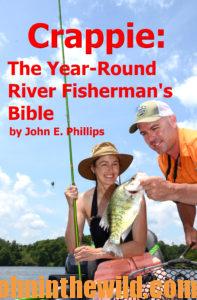 To learn more about crappie fishing, check out John E. Phillips’ brand-new book, “Crappie: The Year-Round River Fisherman’s Bible” at https://amzn.to/2mxWIt4, available in Kindle and print now and by January, 2020 available in Audible.
To learn more about crappie fishing, check out John E. Phillips’ brand-new book, “Crappie: The Year-Round River Fisherman’s Bible” at https://amzn.to/2mxWIt4, available in Kindle and print now and by January, 2020 available in Audible.
Tomorrow: Knowing Techniques to Catch River Crappie in Winter

